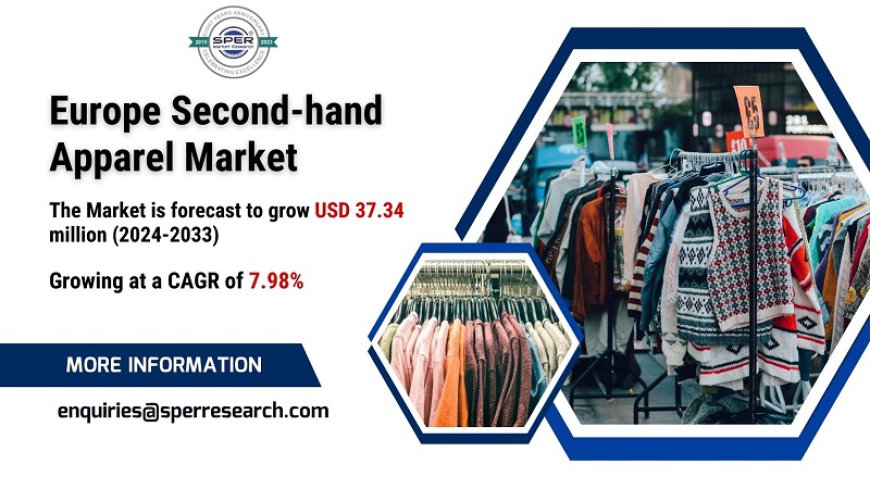Europe Second-hand Apparel Market Growth, Rising Trends, Revenue, Key Players, Business Challenges, Future Opportunities and Forecast till 2033: SPER Market Research
Europe Second-hand Apparel Market is projected to be worth USD 37.34 billion by 2033 and is anticipated to surge at a CAGR of 7.98%.

Second-hand clothing and accessories are items that have previously been owned and used by someone else before being sold again. This category includes a wide range of products, from everyday clothing such as t-shirts and trousers to high-end fashion items and designer pieces. Second-hand clothing caters to all genders and age groups, including men's, women's, and children's clothing, making it suitable for a wide range of customers. Physical thrift stores, consignment shops, and increasingly popular online platforms that allow for easy browsing and purchasing are among the distribution methods for second-hand apparel. Second-hand shopping has grown in popularity as a result of the growing interest in sustainable design, making it an appealing option for environmentally aware shoppers looking for unique trends at reasonable rates.
According to SPER Market Research, ‘Europe Second-hand Apparel Market Size- By Product Type, By Sector, By Consumer Orientation, Sales Channel- Regional Outlook, Competitive Strategies and Segment Forecast to 2033’ states that the Europe Second-hand Apparel Market is estimated to reach USD 37.34 billion by 2033 with a CAGR of 7.98%.
Drivers:
The increasing popularity of circular fashion models is boosting the European second-hand garment market by encouraging sustainability and minimizing waste. Circular fashion is a system in which clothing is designed, manufactured, and consumed with the purpose of extending its lifecycle while reducing environmental effect. This model encourages behaviours like recycling, up cycling, and reselling, which extends the life of clothing and reduces the need for new materials. Companies are increasingly embracing circular economy principles by developing take-back programs that allow customers to return unwanted items for resale or recycling. This move promotes environmental sustainability and opens up new economic prospects in the second-hand garment sector. Companies that handle these issues proactively gain consumer trust and market share.
Restraints:
The second-hand clothes market in Europe confronts a number of constraints that may impede expansion. One big difficulty is that second-hand clothes are perceived to be of worse quality than new ones, which may dissuade some customers from purchasing. Furthermore, the market is influenced by regulatory difficulties, such as tight hygiene and safety regulations, which might complicate the reselling process. Competition from fast fashion firms, which provide trendy and affordable new items, is also a danger since many consumers are drawn to the immediacy and novelty of new products. Furthermore, logistical challenges, like inventory management and effective distribution methods, might limit the scalability of second-hand firms. Finally, fluctuations in consumer spending, especially during economic downturns, may impact the overall demand for used clothing.
Request for Free Sample Report @ https://www.sperresearch.com/report-store/europe-second-hand-apparel-market.aspx?sample=1
The COVID-19 pandemic significantly impacted the Europe second-hand apparel market, initially causing a decline in sales as lockdowns limited consumer access to physical stores. However, the crisis also sparked a surge in online shopping, with many consumers turning to e-commerce platforms for second-hand clothing. This shift not only sustained interest in sustainable fashion but also increased awareness of the environmental benefits of buying pre-owned items. As restrictions eased, the market began to recover, with a growing appreciation for circular fashion practices among consumers.
Europe second-hand apparel market is dominated by Germany due to its strong consumer demand for sustainable fashion. Major players in the market are Artpal, Depop, eBay, Etsy, F&P Stock Solutions.
Europe Second-hand Apparel Market Segmentation:
By Product Type: Based on the Product Type, Europe Second-hand Apparel Market is segmented as; Party, Evening & Occasion, Dresses & Tops, Shirts & T-Shirts, Sweater, Coats & Jackets, Jeans & Pants, Others.
By Sector: Based on the Sector, Europe Second-hand Apparel Market is segmented as; Resale, Traditional Thrift Stores & Donations.
By Consumer Orientation: Based on the Consumer Orientation, Europe Second-hand Apparel Market is segmented as; Men, Women, Kids.
By Sales Channel: Based on the Sales Channel, Europe Second-hand Apparel Market is segmented as; Wholesalers/Distributors, Hypermarkets/Supermarket, Multi-brand Store, Independent Small Stores, Online Retailers, Others.
By Region: This research also includes data for Germany, France, Italy, Spain, UK, Rest of Europe.
For More Information, refer to below link: –
Europe Second-hand Apparel Market Forecast
Related Reports:
Follow Us –
LinkedIn | Instagram | Facebook | Twitter
Contact Us:
Sara Lopes, Business Consultant – USA
SPER Market Research
+1-347-460-2899

 Anthonytone
Anthonytone